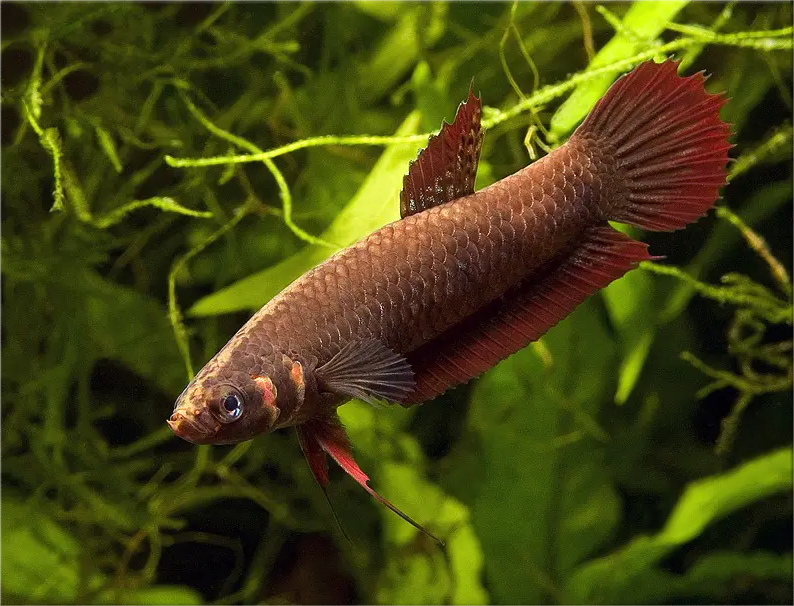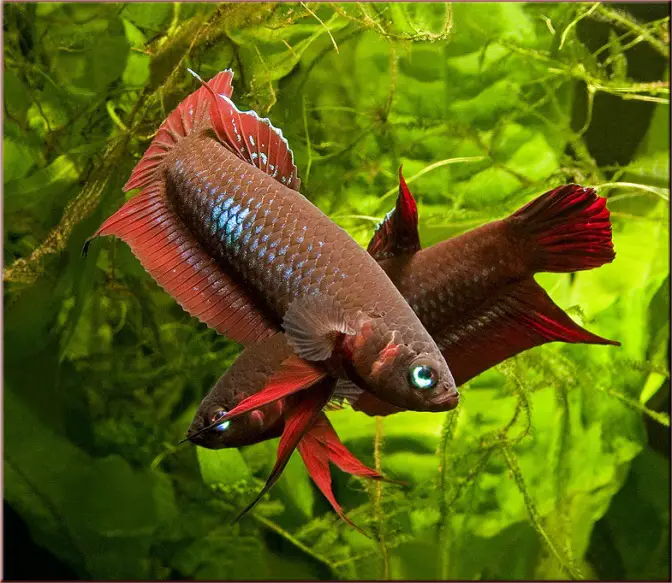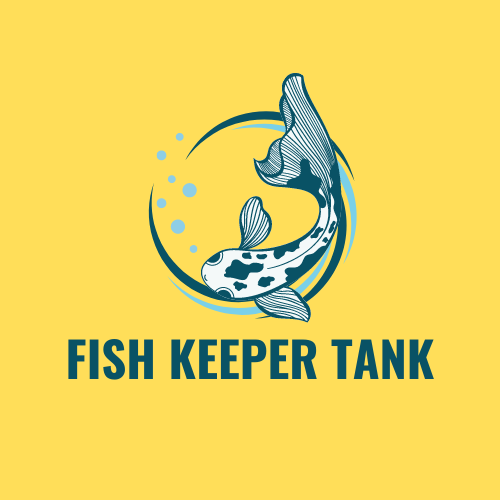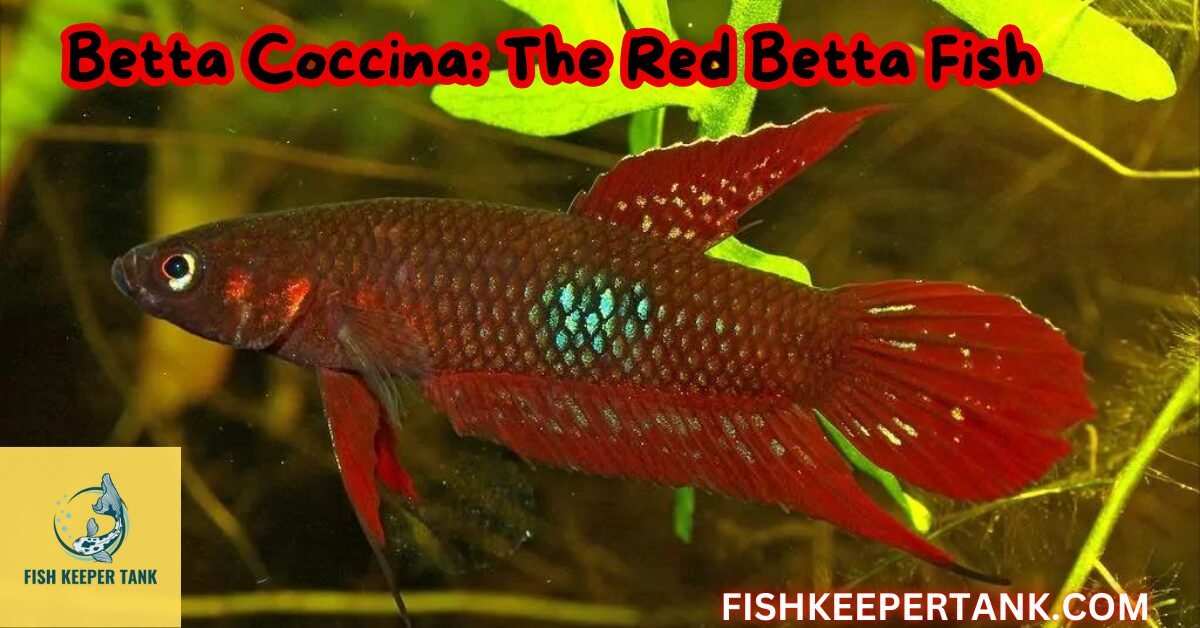Introduction
Betta coccina, commonly referred to as The Red Betta Fish, is a remarkable freshwater species cherished by aquarium enthusiasts for its striking red hues and peaceful temperament. The Red Betta isn’t as famous as the Betta splendens, but it offers a relatively unknown alternative for fish hobbyists looking for a less aggressive and just as mesmerizing fish.
This article “Betta Coccina: The Red Betta Fish” will provide an in-depth guide on Betta coccina, covering its natural habitat, appearance, care requirements, breeding behavior, and compatibility with other species.

Origin and Habitat
In the Wild
Betta Coccina hails from the peat swamps, flooded forests, and rice paddies of Southeast Asia, primarily in Indonesia, Malaysia, and Thailand. Blackwater conditions, high in tannins and pH values between 4.5 and 6.5 are typical for these environments. This shy fish finds ample hiding spots because this natural habitat is so dense with vegetation. In the wild, they eat small insects, larvae and tiny invertebrates.
In Captivity
They do best within an aquarium setup replicating their natural habitat which would involve subdued lighting, a dark substrate and lots of live plants, such as Java fern and Anubias. Driftwood and Indian almond leaves can further enhance the blackwater effect, creating an ideal environment for Betta coccina.
Appearance
Colors and Patterns
The defining feature of Betta coccina is its deep red coloration, often accompanied by iridescent blue or green highlights. Unlike the selectively bred Betta splendens, Betta coccina retains its natural elegance, making it a favorite among aquarists who appreciate understated beauty.
Size and Lifespan
Betta coccina typically grows to a length of 1.5 to 3 inches, making it suitable for nano tanks. Properly cared for, they live 3 to 5 years when their environmental and dietary needs are met.
Just Like Betta Coccina, there are other Betta fish species that you may find interesting to know about, such as:
Betta Imbellis: “The Peaceful Betta”
Behavior and Temperament
Betta coccina is known for its calm and docile nature, distinguishing it from the often aggressive Betta splendens. They are normally peaceful, and can become territorial around breeding time. They are good community tank schoolers with non aggressive same size species. Can Betta Fish Live with Other Fish?
Tank Mates and Compatibility
When selecting tank mates for Betta coccina, it is crucial to choose species that are equally peaceful and thrive in similar water conditions. Suitable companions include:
Harlequin Rasboras
Dwarf Corydoras
Ember Tetras
Do not Keep them with species that fin nip or are aggressive as they will not have the room to themselves and will cause conflict in the tank.
Sexual Dimorphism
Distinguishing between male and female Betta coccina can be challenging. While they do appear to be a little brighter in coloration, and have larger fins, especially when preparing to breed, however, this is more typical for the males. They are usually paler with shorter fins, and are female.
Care and Maintenance
Tank Setup
A minimum tank size of 10 gallons is recommended for a single Betta coccina or a pair. A bigger tank is well suited to a community set up. Key elements of an ideal tank include:
Substrate: Dark sand or gravel
Plants: Java Fern, Java moss and Anubias live plants, or floating plants of any kind
Decor: Caves, Indian almond leaves and driftwood
Lighting: Mimen made for them to inhabit low to moderate to mimic their natural environment.
Water Parameters
Maintaining optimal water conditions is crucial for the health of Betta coccina:
Temperature: 75–82°F (24–28°C). Betta Fish Water Temperature
pH: 4.5–7.0
Hardness: Water that has a low mineral content and is soft
You need to change your water regularly and test your tank. Betta Fish Water Change
Diet
Betta coccina requires a protein-rich diet to thrive. Offer a mix of:
Live foods: brine shrimp, daphnia and bloodworms
Frozen foods: Substitute of high quality for live feed
Pellets: Formulas high in protein and designed for Betta’s
Because you don’t want to overfeed them, you need to feed them 1-2 times a day in small amounts. How Long Can Betta Fish Go Without Food?
Breeding Betta Coccina
Breeding Betta coccina can be a rewarding experience for aquarists just follow the following steps:
Preparing the Breeding Tank
Set up a dedicated breeding tank with the following features:
Like other fungi, truffles grow best in soft, acidic water (pH 5.0–6.0).
It is a warm water reef with average water temperature of 78–82°F.
It includes floating fish plants and too many hiding places.
Breeding pair should be conditioned with a diet of live or frozen foods.
Breeding Behavior
Females are attracted to males which build bubble nests at the water’s surface. Courtship involves the male wrapping around the female in order to prompt her to release eggs. Male fertilizes eggs and puts them in bubble nest.
Raising the Fry
They hatch within 24–36 hours. Initially, Fry fed on their yolk sac, then infusoria and finally finely crushed flakes. Introduce larger foods as they grow, gradually.
Comparison: Betta Coccina vs. Betta Splendens
While both species belong to the Betta genus, they differ significantly:
Aggression: Betta splendens are highly territorial, whereas Betta coccina is more peaceful.
Coloration: Betta splendens come in a wide range of artificial colors, while Betta coccina retains its natural red tones.
Habitat Requirements: Betta coccina prefers blackwater conditions, unlike the hardy Betta splendens.

Conclusion
Betta coccina, the Red Betta Fish, is a stunning and tranquil species that offers a unique alternative to the more common Betta splendens. If provided proper care, they can do well in home aquarium with colors and calm beauty to any setup. For aquarists seeking a manageable yet captivating fish, Betta coccina is a perfect choice.
Frequently Asked Questions
What size tank is best for Betta Coccina?
A tank size of at least 10 gallons is recommended for optimal health and well-being.
Can Betta Coccina live with other fish?
Yes, they can live with peaceful tank mates, but be cautious of aggressive species.
How often should I feed my Betta Coccina?
Feed them small amounts 2-3 times daily and ensure a varied diet for better health.
What water conditions do Betta Coccina prefer?
They thrive in slightly acidic water with a temperature range of 75 to 80°F and a pH of 6.0 to 7.0.
How can I tell if my Betta Coccina is healthy?
Healthy Betta Coccina will have vibrant colors, free-swimming behaviors, and a good appetite.
How do I replicate blackwater conditions for Betta coccina?
To create blackwater conditions, use Indian almond leaves, driftwood, and peat moss. These materials release tannins, which lower the pH and mimic their natural habitat.
How can I tell if my Betta coccina is male or female?
Males typically display brighter colors and larger fins, while females are smaller and have a more subdued coloration. During breeding, males build bubble nests.
What should I feed Betta coccina?
Feed them a varied diet of live or frozen foods like bloodworms, daphnia, and brine shrimp. Supplement with high-quality Betta pellets for balanced nutrition.
How often should I change the water in a Betta coccina tank?
Perform partial water changes (20–30%) weekly to maintain water quality. Blackwater tanks may require less frequent changes but always monitor pH and ammonia levels.
People Also Read:

